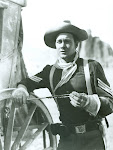
“Broncho Billy” Anderson was the stage name of Gilbert Maxwell Aronson, America’s first cowboy movie star. Anderson pioneered the genre that eventually produced stars such as John Wayne, Gary Cooper, Roy Rogers, Buck Jones, and Tom Mix. Anderson also worked behind the camera as a director and producer and developed production techniques still in use today. He was awarded a special Oscar by the Academy of Motion Picture Arts and Sciences in 1958.
Max Aronson was born in 1880 in
Little Rock (Pulaski County). His parents were Henry, a traveling salesman, and Esther Aronson. The Aronsons had seven children. Most of the children were born in Texas, but Max was born in Arkansas. Aronson moved to
Pine Bluff (Jefferson County) in the 1890s to work for his brother in law, Louis Roth, who had married Aronson’s sister, Gertrude, and who worked as a cotton broker. He left Arkansas around the turn of the century for New York, where he became involved with the old Vitagraph Company, a theatrical group. From 1900 until 1926, Aronson produced, directed, or appeared in more than 600 motion pictures—everything from the one reelers, movies that consisted of approximately 400 feet of film, to full-length motion pictures that consisted of approximately 2,000 feet of film, produced later in his career. By 1902, Aronson was in New York and, in 1903, was cast in Edwin S. Porter’s film, The Great Train Robbery,a classic silent western. In his early films, he played various roles under the name G. M. Anderson, as in the movie Raffles, the Amateur Cracksman for Vitagraph in 1904, the first film Anderson directed. In 1907, Anderson moved to Chicago to produce films. There, he developed the idea that the public would pay to see good western movies, and the era of “cowboy” films, that is, films based on marketing the name of the cowboy, began. For a short time, he produced films in Colorado, but William Selig, an early movie producer for whom Anderson was working, could not see the advantage of western scenery in their releases. Anderson’s contribution was to develop the western film and the techniques he devised, including the “long shot,” “medium shot,” “close up,” and “reestablishment scene,” have become standard techniques present even in modern westerns. Back in Chicago, Anderson partnered with George K. Spoor, a theatrical booking agent. The two of them established Essanay Studios in 1907, the name being derived from a phonetic spelling of their initials, S and A. Anderson married Molly Louise Schabbleman in 1908, and the couple had one child, Maxine.
From 1908 to 1915, Anderson made 375 westerns. The most famous of these was the Broncho Billy series. Anderson read a story in the Saturday Evening Post about a character called Broncho Billy. He liked the idea of a series character and developed Broncho Billy into a franchise of films which were extremely popular with the American public. Anderson established a studio at Niles, California, in 1912, where he turned out a two-reel Broncho Billy story approximately every two weeks. The films cost approximately $800 per movie to produce, and each grossed approximately $50,000. The Essanay Studios were in their heyday. Many legendary Hollywood stars worked at Essanay—Francis X. Bushman, one of the leading stars of his day, Gloria Swanson, and Charlie Chaplin. Anderson signed Chaplin for the unheard of salary of $1,250 per week, plus a bonus of $10,000, but neither Spoor nor Chaplin were happy with the arrangement. Spoor was shocked by the salary, and Chaplin was not happy with either the Chicago or Niles studios and their regimented way of mass-producing films. At Niles, Anderson and Chaplin appeared together in Chaplin’s thirty-eighth film, The Champion, released in March of 1915, the only film in which the two stars appeared together. The Bushman, Chaplin, and Anderson movies produced substantial profits for Essanay, but the studio began to experience problems. First, Chaplin was hired away by Mutual for $10,000 a week and a $150,000 signing bonus. Then, Anderson began to realize that the public was demanding more than simple two-reelers. He approached Spoor about producing longer, more involved features. Spoor did not want to incur more expense for longer productions, so Anderson eventually sold his interest in Essanay in 1916. The separation contract stipulated that Anderson could not engage in motion picture production for two years and that the Broncho Billy character would remain property of Essanay. For all practical purposes, Anderson retired. Essanay finally dropped out of the film production business. In 1918, Anderson attempted producing westerns again, but the public had new heroes on the silver screen, and the franchise ceased. In 1958, Anderson was awarded an honorary Oscar by the Academy of Motion Picture Arts and Sciences for his contribution to the development of motion pictures as entertainment. He lived in quiet retirement for most of his remaining years but surfaced again in the publicity of receiving his honorary Oscar. He died in Pasadena, California, on January 20, 1971, of a heart attack.
(From the Encyclopedia of Arkansas History)









































